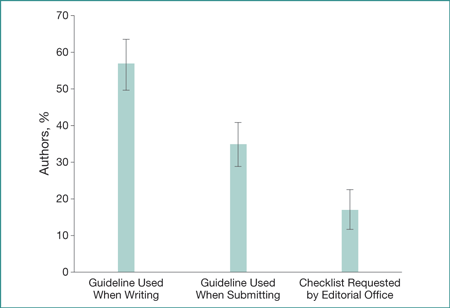Abstract
Introducing Reporting Guidelines and Checklists for Contributors to Radiology: Results of an Author and Reviewer Survey
Marc Dewey,1 Deborah Levine,2,3 Patrick M. Bossuyt,4 Herbert Y. Kressel5,6
Objective
Numerous reporting guidelines have been developed to make study reports more informative, but it is uncertain whether they are perceived as useful by authors and reviewers. We surveyed the use and perceived value of reporting guidelines after an initiative begun in January 2016 that required authors to submit appropriate guideline checklists along with their manuscripts prior to peer review.
Design
Cohort study of authors of original research submissions to Radiology between July 5, 2016, and June 1, 2017, and of reviewers who had performed reviews since January 2016. Authors were asked to complete an anonymized online survey within 2 weeks of manuscript submission but before the editorial decision was made. Reviewers were surveyed with similar questions from May 17, 2017, until June 1, 2017.
Results
A total of 831 of 1391 authors (59.7%) completed the survey within a mean (SD) of 1.5 (2.7) days (range, 0-17 days) of the request. Consistent with the types of studies submitted to Radiology, most authors used STROBE (447 of 829 authors [53.9%]) or STARD (313 authors [37.8%]) and only a small minority used CONSORT (40 authors [4.8%]) or PRISMA (29 authors [3.5%]). Only 120 of 821 authors (14.6%) used the guideline and checklist when designing the study, more so for PRISMA users (16 of 29 [55%]), less so for STARD users (52 of 310 [16.8%]; P < .001) and STROBE users (46 of 443 [10.4%]; P < .001). The guidelines were used by 189 of 821 authors (23.0%) when writing the manuscript; these authors more often reported an impact on the final manuscript (107 of 189 [56.6%]) compared with those who used the guideline when submitting the manuscript (95 of 272 [34.9%]; P < .001) or when the checklist was requested by the editorial office (41 of 240 [17.1%]; P < .001) (Figure). Filling out the checklist was considered very useful by 256 of 819 authors (31.3%), somewhat useful by 390 (47.6%), not very useful by 122 (14.9%), and not at all useful by 51 (6.2%). The response rate of reviewers was 32.1% (259 of 808 reviewers). The checklist was used by 200 of 259 reviewers (77.2%) some or all of the time, and 119 of 199 (59.8%) said it affected their reviews. Having the checklist for review was considered very useful by 28 of 256 reviewers (10.9%), somewhat useful by 106 (41.4%), not very useful by 82 (32.0%), and not at all useful by 40 (15.6%).
Figure. Impact on Manuscripts Depending on When Guideline and Checklist Were Used
Significantly more authors who used the guidelines and checklist when writing the manuscript reported an impact on the final manuscript (107 of 189 authors [56.6%]) compared with those who used the guideline when submitting the manuscript (95 of 272 authors [34.9%]; P < .001) or when the checklist was requested by the editorial office (41 of 240 authors [17.1%]; P < .001). Error bars show 95% CIs.
Conclusions
Almost 4 of 5 authors and half of the reviewers judged the guideline checklists to be useful or very useful. Using the guidelines while writing the manuscript was associated with greater impact on the final manuscript.
1Department of Radiology, Charité–Universitätsmedizin Berlin, Berlin, Germany, marc.dewey@charite.de; 2Beth Israel Deaconess Medical Center, Harvard Medical School, Boston, MA, USA; 3Senior Deputy Editor, Radiology, Boston, MA, USA; 4Amsterdam Public Health Research Institute, Department of Clinical Epidemiology, Biostatistics, and Bioinformatics, University of Amsterdam, Amsterdam, the Netherlands; 5Department of Radiology, Harvard Medical School, Boston, MA, USA; 6Editor, Radiology, Boston, MA, USA
Conflict of Interest Disclosures:
Marc Dewey was an Associate Editor of Radiology at the time of initiation of this study and is a consultant to the editor now. Debbie Levine is Senior Deputy Editor of Radiology. Patrick Bossuyt is the lead senior author of the STARD guidelines and checklist. Herbert Y. Kressel is the Editor in Chief of Radiology and an author of the STARD 2015 guidelines.
Funding/Support:
This study was supported by the Young Leaders Club program of the International Society of Strategic Studies in Radiology and the Heisenberg Program of the German Research Foundation.
Role of the Funder/Sponsor:
The funders had no role in the design and conduct of the study; collection, management, analysis, and interpretation of the data; preparation, review, or approval of the abstract.

